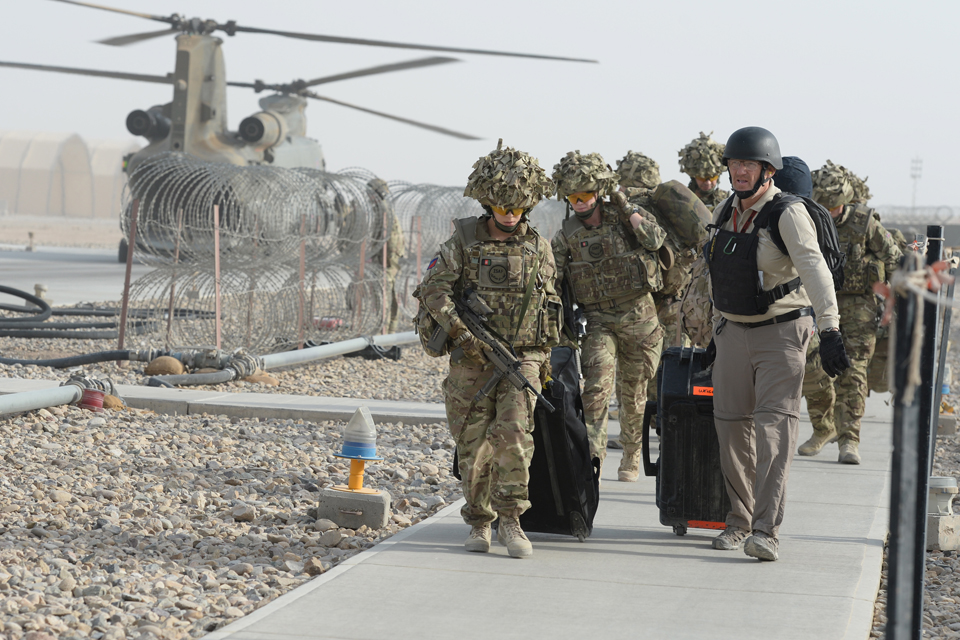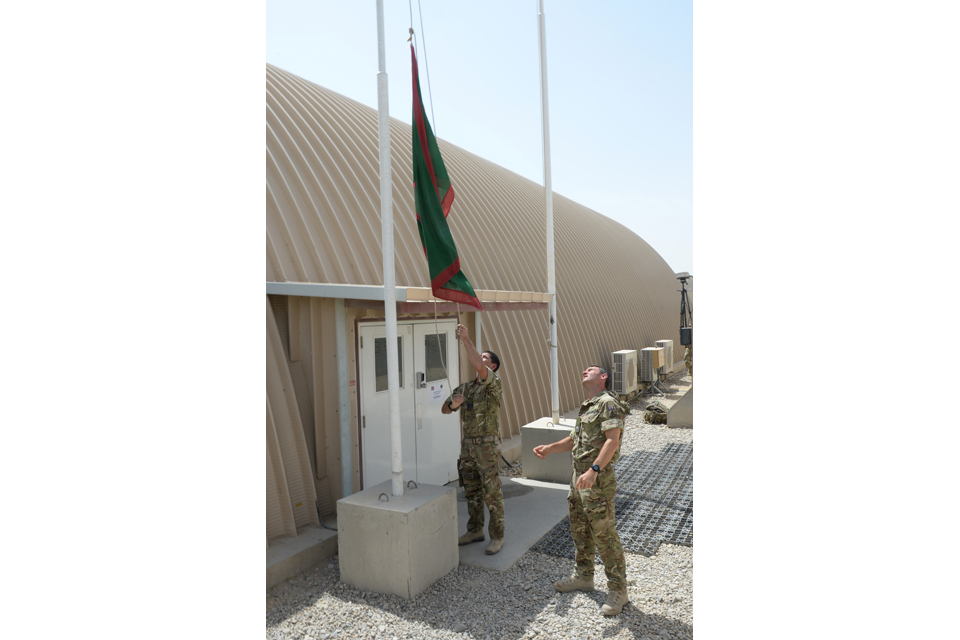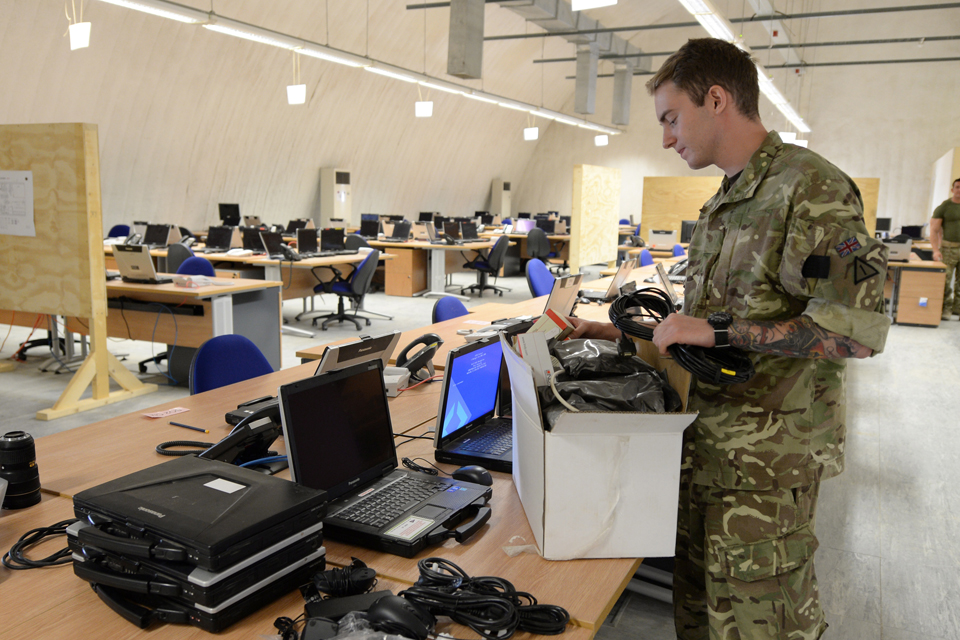Task Force Helmand HQ leaves Lashkar Gah
The headquarters of UK military forces in Afghanistan has moved from Lashkar Gah to Camp Bastion in an early morning helicopter operation.
![Service personnel at a flag ceremony at Camp Bastion to mark the relocation of Task Force Helmand [Picture: Sergeant Barry Pope, Crown copyright]](https://assets.publishing.service.gov.uk/media/5a610f05e5274a443e00820d/s300_AMOC-CCT-2013-190-004.jpg)
Service personnel marking the relocation of Task Force Helmand
The move, which was completed on 9 August, has been hailed as probably the most complex headquarters move on operations ever undertaken by the British Army.
Task Force Helmand (TFH) headquarters has been based in Lashkar Gah since May 2006, co-ordinating UK operations across Helmand province for over 7 years. The headquarters has now moved to Camp Bastion, the main hub of UK forces in Afghanistan.
The move reflects the fact that Afghan security forces now plan and conduct their own operations across the province and the UK military presence outside Camp Bastion is consequently in the process of drawing down.

Headquarters staff from 1st Mechanized Brigade moving from Lashkar Gah to Camp Bastion [Picture: Sergeant Barry Pope, Crown copyright]
The UK Secretary of State for Defence, Philip Hammond, said:
The growing capability of the Afghan security forces our troops have trained is allowing us to reduce the number of UK forces in Afghanistan this year – and the relocation of HQ Task Force Helmand from Lashkar Gah to our main base at Camp Bastion marks a key milestone as we draw down. By the end of next year the UK’s combat operations in Afghanistan will be over.
In a carefully planned operation, key staff from the headquarters – which is led by the British Army’s 1st Mechanized Brigade – flew via Chinook to Camp Bastion in the early morning of 9 August 2013 to join an advance party already in place. A series of helicopter moves throughout the day ferried the remaining staff over to ensure the transition of control was seamless. Control was formally handed over to the new headquarters at around 10am local time the same morning.
A short ceremony was then held in memory of those members of the Armed Forces who have lost their lives on operations in Afghanistan.

The new Task Force Helmand headquarters building at Camp Bastion in Afghanistan [Picture: Sergeant Barry Pope, Crown copyright]
Brigadier Rupert Jones, Commander TFH, said:
The brigade headquarters move was seamless, both operationally and technically, thanks to the hard work of a great many people both here in Helmand and also right across Defence. It represents probably the most complex HQ move on operations ever undertaken by the British Army.
The move of the headquarters from Lashkar Gah is a significant moment in the campaign and reflects the progress made by the Afghan security forces and that they are now in the lead for security across Helmand. The move is in line with our progressive lift off from the Afghan security forces.
The move brings to an end a significant chapter in the British Army’s history with the headquarters at Lashkar Gah having controlled a great many feats of arms by TFH through the years.
The move follows the formal progression of TFH’s Brigade Advisory Group, made up of soldiers from 4th Battalion The Rifles, from advising their counterparts in the Afghan National Army’s 3/215 Brigade at the kandak (battalion) level to the brigade level.

The 1st Mechanized Brigade flag being raised at the new Task Force Helmand headquarters at Camp Bastion [Picture: Sergeant Barry Pope, Crown copyright]
Brigadier Jones added:
With our advising role now focused at the brigade level, this was the right time to move the Task Force headquarters to be next to that of our counterparts in 3/215 Brigade at Camp Shorabak.
Major Dan Ashton, from the Royal Corps of Signals, was responsible for co-ordinating the challenging project. He said:
Ensuring that the brigade’s units were fully supported throughout this relocation was critical. The ability of the brigade staff to work at the same level of operational tempo whilst split across 2 locations has been hugely impressive and is testament to the quality of the people within the headquarters. The level of support required to facilitate this move has been incredibly far-reaching, incorporating organisations across Afghanistan and the UK.
The HQ relocation was a technical and logistical feat, with a number of previously unencountered challenges, but has set the conditions for 1st Mechanized Brigade’s successors and the successful redeployment of UK forces from Afghanistan.

215 Signal Squadron personnel installing communications equipment inside the new Task Force Helmand headquarters at Camp Bastion [Picture: Sergeant Barry Pope, Crown copyright]
Major Liz Byfield, Officer Commanding 215 Signal Squadron, responsible for the technical aspects of the move, said:
The complexity and technical challenges of the move should not be underestimated. It required communication specialists from across Afghanistan and the UK to support. It wasn’t just the sheer amount of IT we had to move, but the number of different systems which interact with each other, with different levels of security classification, which made the move a huge undertaking.
It’s the little things you don’t always think of at the beginning – like US equipment running on different types of power – which made things more difficult.